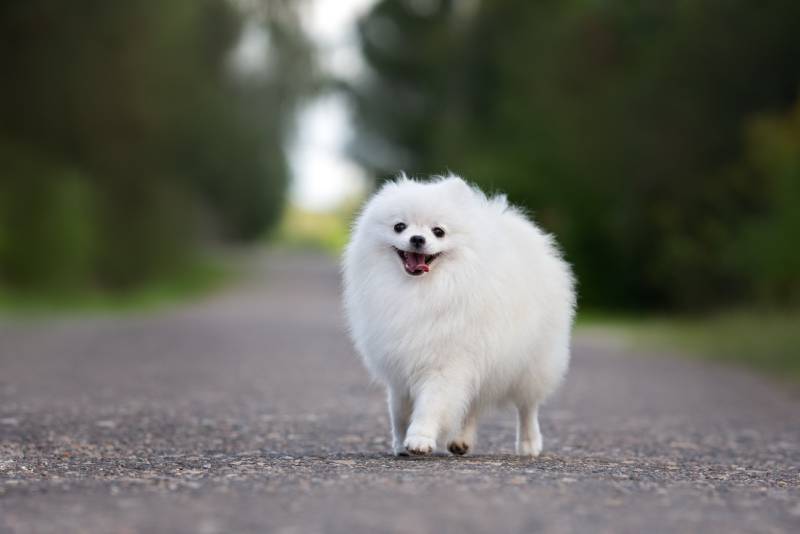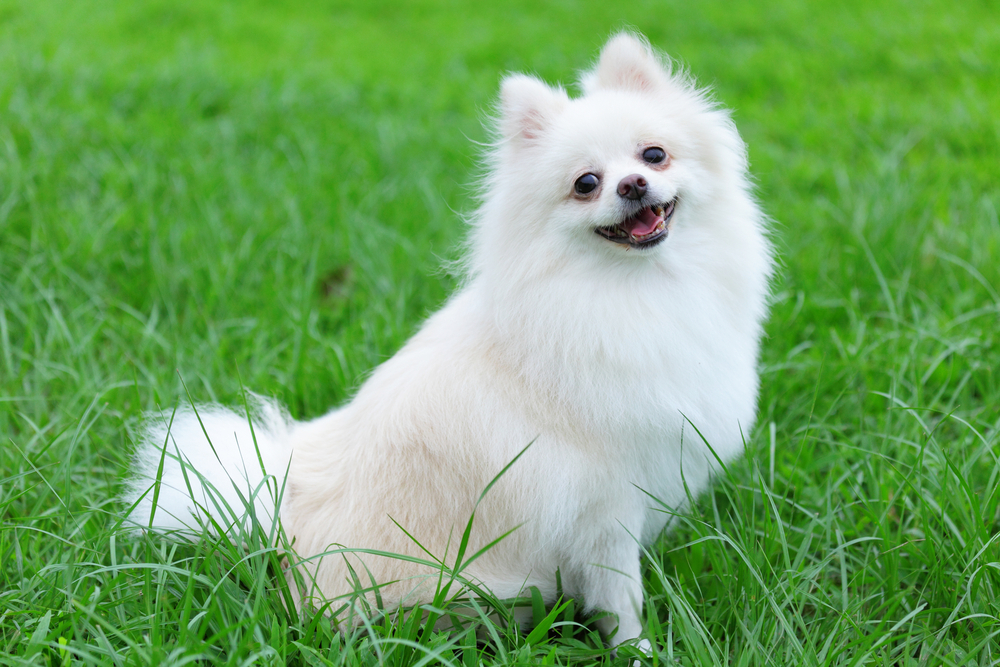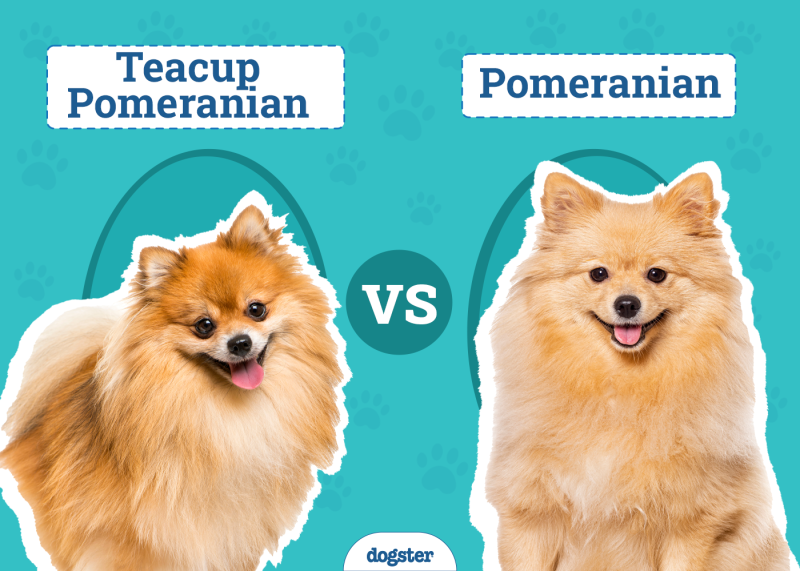Although they’re a descendant of large, working dogs, the White Pomeranian is a tiny dog, typically weighing less than 6 pounds. You wouldn’t know they were tiny by their demeanor, however. Most Pomeranians are very vocal, love being the center of attention, and will go above and beyond to please their owners. If you’re considering adopting a White Pomeranian, read on. We have valuable facts and info about this remarkable dog below.
Breed Overview
Height:
6–7 inches
Weight:
3–7 pounds
Lifespan:
12–16 years
Colors:
Pure white is the only acceptable color for a White Pomeranian
Suitable for:
City life, apartment life, families with older children, singles, seniors
Temperament:
Affectionate, happy, energetic, and adaptable to many situations and environments
White Pomeranian Breed Characteristics

The Earliest Records of White Pomeranians in History
While it’s difficult to say exactly when the White Pomeranian was first bred, paintings from 18th-century England featured a White Pomeranian and some Poms with mixed colors. Also, a painting requested by the Prince of Wales, King George Ⅳ, depicted him and his pet Pomeranian, Fino, in 1791.
The White Pomeranian back then wasn’t the one we know about today. Back then, they were bigger dogs, and some weighed 30 pounds. However, they looked very similar to today’s Pomeranians, with similar features identifying them as a classic Spitz breed.
By 1888, when Queen Victoria of England was given a Pomeranian named Marco, the breed had already been greatly reduced in size. Marco, for example, weighed in at almost 12 pounds. Another Pom gifted to the Queen during that time was Gena, a female who weighed less than 8 pounds. These dogs were much closer to the White Pomeranians we see today.

How White Pomeranians Gained Popularity
You may be surprised to know that White Pomeranians became very popular during the Renaissance in England. Many of the world’s premier artists at the time had Pomeranians, including Mozart.
It wasn’t until Queen Victoria of England, who we mentioned earlier, that the White Pomeranian truly started becoming popular, at least in England. In the United States, the first Pomeranians arrived in the late 1800s and gained popularity quickly. That was especially true after it was discovered that two Pomeranians were survivors of the Titanic!
Formal Recognition of White Pomeranians
It was in 1888 that the American Kennel Club (AKC) formally recognized the Pomeranian as a distinct and separate breed. Today the Pomeranian is accepted by canine organizations worldwide, including the White Pomeranian.
- Australian National Kennel Club
- Canadian Kennel Club
- Federation Cynologique Internationale
- New Zealand Kennel Club
- United Kennel Club
- The UK Kennel Club
To be a true White Pomeranian, a Pom must be 100% white, with no shadings or marking whatsoever. Also, their eyes and noses must be dark or black. It’s also worth noting that white is 100% accepted and was one of the breed’s original colors. Lastly, the registration code for a White Pomeranian with the AKC is 199.


Top 7 Unique Facts About White Pomeranians
1. Two Pomeranians Survived the Titanic disaster
The first was owned by Margaret Rothschild (the dog’s name was never revealed), and the second, Lady, was owned by Margaret Hays.
2. White Is One of the Original Pomeranian Colors
Today, over 18 colors are accepted by the AKC for Pomeranians, but the White Pom was one of the original colors.
3. “Throwback “ Pomeranians Are Larger
Occasionally, a Pomeranian is born that harkens back to their ancestors. They look more like the original Spitz breed and weigh up to 20 pounds.

4. When He Painted the Sistine Chapel, Michelangelo’s Pomeranian Was With Him
As he painted high up in the arches of the chapel, the great one’s loyal Pom sat below and watched contentedly.
5. It Can Take Five Generations to Produce a White Pomeranian
While one of the first, the white color is one of the hardest to find. This is especially true now that there are so many other colors of Pomeranian.
6. Tears Can Stain a White Pom’s Coat
Because of the lack of color, it’s easy to see tears on a White Pomeranian’s coat. If your White Pom has tear stains, clean them off as early as possible since they will be very noticeable.
7. White Pomeranians Are Expensive
With them being hard to find, you can bet that White Pomeranians are expensive, but their actual cost may surprise you. While prices vary, you can expect to pay upwards of $9,000 for a pure white Pomeranian. However, the occasional Pomeranian finds its way to a local shelter, where the price to adopt will be a mere fraction of the cost.


Do White Pomeranians Make Good Pets?
Pomeranians of every color, including White Pomeranians, make excellent pets and companions. They are outgoing, energetic dogs that love being the center of attention and will follow you wherever you go. They live to please their adoptive families and get along well with kids. However, they are delicate and are better for homes with older children. White Pomeranians are excellent apartment dogs because they’re compact and don’t need much outdoor activity. However, they can be incredibly vocal, so keep that in mind if you live in a crowded apartment complex. Lastly, because of their affectionate nature and small size, Pomeranians are great companion dogs for seniors.

Final Thoughts
Pomeranians have been around for hundreds of years and have been a popular breed throughout much of that time. They’ve changed quite a bit since the species was first seen; they’re much smaller and bred today more for companionship than their original function, which was pulling sleds and herding.
Today’s White Pomeranian is a genuinely affectionate, outgoing dog that loves attention and will do whatever it takes to get it. That makes the White Pom easier to train and also means that, once bonded, you’ll have a tiny friend for life. If you adopt a White Pomeranian, they will be the smallest member of your family but likely have the biggest voice.
See Also:
- Teacup Pomeranian: Pictures, Care Guide, Temperament & Traits
- I Think My Neighbor Poisoned My Dog, What Can I Do? Vet Approved Advice
Featured Image Credit: Tam and Trace Photography, Shutterstock



















3 Responses
nice dog
Thanks for the info. I've got 2 white and black cats, bro and sis, 8 yrs old house cats. Will the little man I'm interested in get along with my kitties?